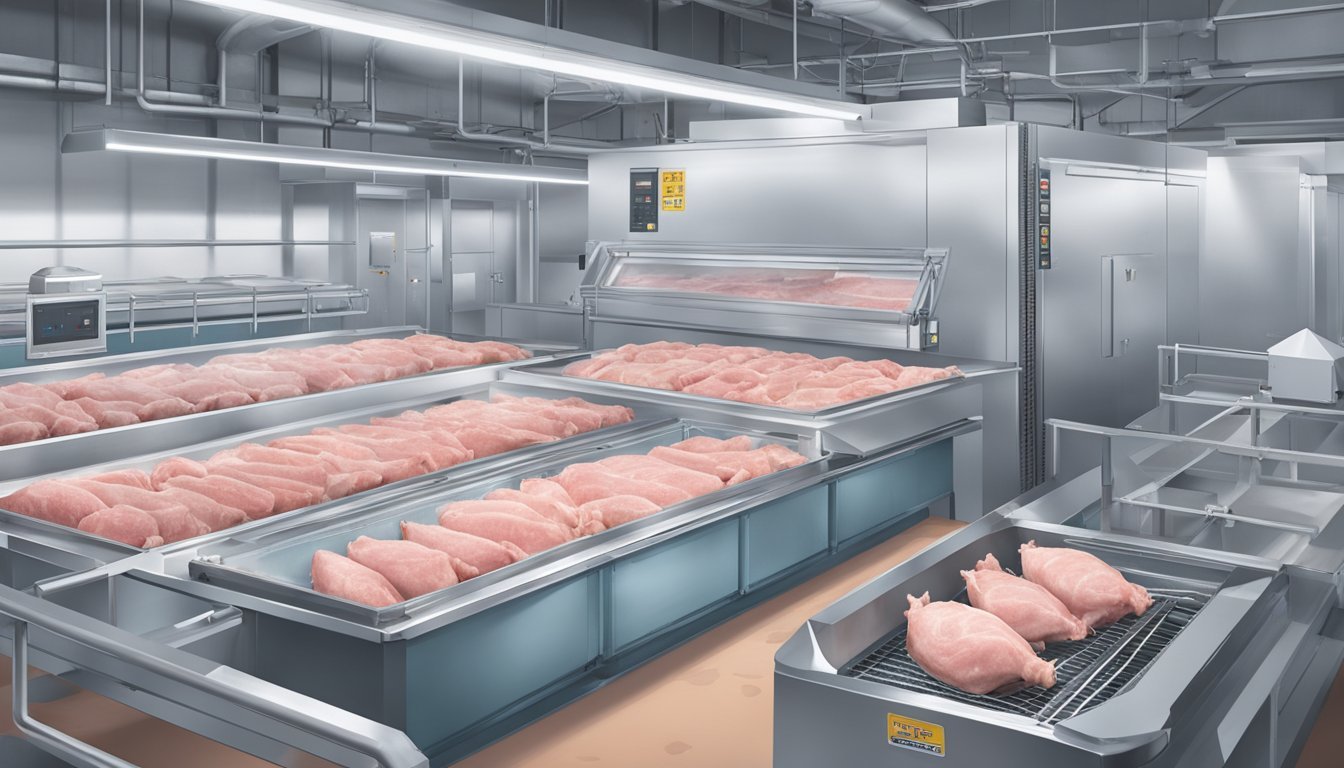Frozen vs Fresh Pork: A Juicy Comparison
Pork lovers often face a dilemma when choosing between frozen and fresh cuts at the grocery store. The decision can impact taste, texture, and overall meal quality. While fresh pork is widely considered superior, frozen options offer convenience and extended shelf life.
Both fresh and frozen pork can be equally nutritious and flavorful when handled properly. Fresh pork typically has a firmer texture and may retain slightly more moisture during cooking. Frozen pork, when thawed correctly, can closely match the quality of fresh cuts.
The choice between fresh and frozen pork ultimately depends on individual preferences and circumstances. Fresh pork is ideal for immediate use, while frozen options provide flexibility for meal planning and reduce food waste. Proper storage and preparation techniques are key to maximizing the quality of both fresh and frozen pork.
Comparative Overview of Frozen vs. Fresh Pork
Frozen and fresh pork offer distinct advantages and characteristics that impact quality, convenience, and usage. Their differences span preservation methods, shelf life, texture, and flavor profiles.
Definition and Basics
Frozen pork undergoes rapid freezing shortly after processing, preserving its nutritional content and extending shelf life. This method creates ice crystals within the meat, potentially affecting texture upon thawing. Fresh pork, in contrast, is chilled and sold without freezing, maintaining its original texture and moisture content.
Frozen pork can be stored for several months when kept at 0°F (-18°C) or below. Fresh pork requires refrigeration and should be consumed within a few days of purchase. Both types offer similar nutritional value, but fresh pork may have a slight edge in flavor and texture when prepared immediately.
Market Availability
Fresh pork is readily available in most supermarkets and butcher shops, offering consumers immediate cooking options. It's ideal for shoppers who prefer to use the meat promptly or enjoy spontaneous meal planning.
Frozen pork provides greater flexibility and convenience. It allows for bulk purchasing and reduces the frequency of grocery trips. Many cuts and varieties of pork are available frozen, from chops to roasts. This option is particularly useful for those living far from fresh meat sources or wanting to stock up for future use.
Seasonal availability can impact fresh pork prices, while frozen options tend to have more stable pricing year-round. Some specialty cuts or organic varieties may be more accessible in frozen form due to longer storage capabilities.
Quality Considerations
Fresh and frozen pork differ in key quality aspects. These variations impact the meat's texture, flavor profile, and nutritional content. Understanding these differences helps consumers make informed choices.
Impact on Texture
Freezing pork can affect its texture due to ice crystal formation. Fresh pork typically has a firmer, more desirable texture. When thawed, frozen pork may be slightly softer and have a different mouthfeel. This is because ice crystals can damage cell walls, leading to moisture loss during thawing and cooking.
Proper freezing techniques can minimize texture changes. Rapid freezing at very low temperatures produces smaller ice crystals, reducing cellular damage. Vacuum-sealing pork before freezing also helps maintain quality by reducing freezer burn.
Effect on Taste
Fresh pork often has a more pronounced flavor compared to its frozen counterpart. This is partly due to the minimal processing and handling fresh meat undergoes. Frozen pork may experience slight flavor changes during storage, especially if not properly packaged.
Proper thawing is crucial for preserving taste. Slow thawing in the refrigerator helps retain flavor better than rapid thawing methods. Some cuts, like bone-in steaks, may benefit from freezing as it can help tenderize the meat.
Nutritional Differences
The nutritional content of pork remains largely unchanged between fresh and frozen varieties. Both forms retain similar levels of protein, fat, and essential nutrients. However, prolonged freezer storage may lead to minor nutrient losses, particularly in vitamins.
Fresh pork might have a slight edge in nutrient retention, as it hasn't undergone the freezing process. The fat content and distribution remain consistent in both fresh and frozen pork, assuming proper storage conditions.
Connective tissue in pork is not significantly affected by freezing. Both fresh and frozen cuts maintain their collagen structure, which contributes to the meat's texture and cooking properties.
Preservation and Shelf Life
Proper storage techniques are crucial for maintaining pork quality and safety. Freezing and refrigeration offer different advantages for preserving pork products.
Freezing Process
Freezing pork halts bacterial growth and extends shelf life significantly. At 0°F (-18°C), pork can be stored indefinitely, though quality may decline over time. Ice crystals form during freezing, which can affect texture and flavor.
For optimal results, freeze pork quickly at -10°F (-23°C) or below. This rapid freezing minimizes ice crystal size, preserving meat quality.
Different cuts have varying recommended freezer storage times:
Roasts, steaks, chops: 4-6 months
Ground pork: 3-4 months
Cooked pork dishes: 2-3 months
Refrigeration of Fresh Pork
Fresh pork requires careful refrigeration to maintain safety and quality. Store fresh pork at 40°F (4°C) or below to slow bacterial growth.
Refrigerated storage times for fresh pork:
Steaks, chops, roasts: 3-5 days
Ground pork: 1-2 days
Keep pork in sealed containers or wrapped tightly to prevent cross-contamination. Place pork on the bottom shelf of the refrigerator to prevent drips onto other foods.
Signs of Freezer Burn
Freezer burn occurs when moisture evaporates from the pork's surface, leaving dry, discolored patches. Signs include:
Gray or brown spots
Dry, leathery texture
Ice crystals on the surface
While freezer-burned pork is safe to eat, it may have an unpleasant taste and texture. To prevent freezer burn, wrap pork tightly in moisture-proof packaging before freezing.
Risks of Bacterial Growth
Improper storage can lead to bacterial growth, posing health risks. Harmful bacteria like Salmonella and E. coli can multiply rapidly in the "danger zone" between 40°F and 140°F (4°C and 60°C).
Never thaw pork at room temperature. Instead, thaw in the refrigerator, cold water, or microwave. Cook thawed pork immediately.
Signs of spoilage include:
Sour or off odors
Slimy texture
Changes in color
Discard any pork showing these signs to avoid foodborne illness.
Handling and Preparation
Proper handling and preparation of pork, whether frozen or fresh, is crucial for food safety and optimal flavor. Key techniques include safe thawing, cooking from frozen, and preparing fresh cuts.
Thawing Techniques
Thawing frozen pork safely prevents bacterial growth. The refrigerator method is ideal, allowing slow, even thawing. Place the pork on a tray to catch drips and allow 24 hours per 4-5 pounds. For faster results, use the cold water method. Submerge vacuum-sealed pork in cold water, changing it every 30 minutes. This takes about 1 hour per pound.
Microwave thawing is quick but can partially cook the meat. Use the defrost setting and cook immediately after thawing. Never thaw pork on the counter, as this promotes bacterial growth in the "danger zone" temperatures.
Cooking from Frozen
Cooking pork directly from frozen is possible but requires extra time. Increase cooking time by about 50% compared to thawed meat. Use a meat thermometer to ensure the internal temperature reaches 145°F for whole cuts or 160°F for ground pork.
Slow cookers are not recommended for frozen pork due to food safety concerns. Instead, use an oven or pressure cooker. For best results, season frozen pork after it has been cooking for a while and the surface has thawed.
Preparation Tips for Fresh Pork
Fresh pork requires minimal preparation. Trim excess fat if desired, but leave some for flavor. Pat the meat dry with paper towels before seasoning to ensure a good sear. For enhanced tenderness, consider dry-aging fresh pork in the refrigerator for 1-3 days.
Marinating fresh pork can add flavor and moisture. Use acid-based marinades sparingly as they can toughen the meat. For best results, marinate for 2-12 hours in the refrigerator. Always discard used marinade to prevent cross-contamination.
Technological Advances in Freezing
Recent innovations in freezing technology have revolutionized pork preservation. These advancements aim to maintain meat quality and extend shelf life through rapid freezing and improved packaging methods.
Flash-Freezing Technology
Flash-freezing exposes pork to extremely low temperatures, typically below -30°C (-22°F), in a matter of minutes. This rapid process forms smaller ice crystals within the meat, reducing cellular damage and preserving texture.
The technique uses liquid nitrogen or specialized freezing chambers to achieve rapid temperature drops. Flash-frozen pork retains more moisture upon thawing, resulting in better flavor and tenderness compared to conventional freezing methods.
Food processors often employ this technology immediately after butchering to lock in freshness. Flash-freezing also helps preserve nutritional value by minimizing enzymatic breakdown during the freezing process.
Vacuum Sealing for Freshness
Vacuum sealing removes air from packaging before sealing, creating an oxygen-free environment around the pork. This technique significantly slows oxidation and bacterial growth, extending the meat's freezer life.
Modern vacuum sealers use heavy-duty plastic bags designed to withstand freezer temperatures. The tight seal prevents freezer burn and ice crystal formation on the meat's surface.
Vacuum-sealed pork can maintain quality for up to 12 months in the freezer, compared to 4-6 months for conventionally wrapped cuts. This method also helps preserve the meat's color and reduces the risk of off-flavors developing during storage.
Combining vacuum sealing with flash-freezing offers optimal preservation, ensuring that frozen pork closely mimics the quality of fresh cuts when thawed and cooked.
Consumer Perception and Expectations
Consumer perceptions and expectations play a crucial role in pork purchasing decisions. Visual cues, freshness indicators, and evolving preferences shape how consumers evaluate and choose pork products.
Visual Appearance and Color
Pork color significantly influences consumer choices at the point of purchase. Consumers generally prefer fresh pork with a pinkish-red hue, associating it with quality and freshness. Pale or grayish pork is often perceived as less appealing or potentially spoiled.
Marbling, the intramuscular fat visible in meat, also affects consumer perceptions. Some shoppers equate marbling with flavor and tenderness, while others may view it as less healthy.
Packaging can impact visual appeal. Clear packaging allows consumers to assess the meat's color and quality directly, potentially increasing purchase likelihood for visually appealing cuts.
Expectations of Freshness
Consumers typically associate freshness with superior taste, texture, and nutritional value in pork. Many shoppers prefer purchasing from butcher counters or packaged pork with recent packaging dates.
Odor plays a role in freshness perception. Consumers expect fresh pork to have a mild, clean scent. Any off-odors are quickly associated with spoilage or poor quality.
Texture is another freshness indicator. Consumers expect fresh pork to be firm to the touch, with minimal moisture or stickiness on the surface.
Consumer Preference Trends
Health consciousness is driving some consumers towards leaner pork cuts. There's growing interest in pork from animals raised without antibiotics or hormones.
Convenience remains a key factor. Pre-portioned and easy-to-cook pork products are gaining popularity among time-pressed consumers.
Ethical considerations are influencing purchasing decisions. Some consumers seek out pork from farms with high animal welfare standards or sustainable practices.
Local and artisanal pork products are trending in some markets. Consumers may perceive these as fresher or of higher quality than mass-produced alternatives.





